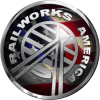BNSFdude wrote:Do note the engine was off, and so it wasn't able to fill the Main Res back up to 140. The set I took was a 20lb set, but maybe I did bail it off.
Do take note of the Red needle in the right gauge (That's the BC), it's set to go up to 72PSI, as it has the older Flexicoil trucks with Comp shoes.
Woody, I understand the engine was shut down and from the video it looks like you have about 100 psi in the main reservoir. At the beginning of the video It looks like you've drawn the equalizing reservoir and brake pipe down to zero, probably by putting the automatic brake handle in the handle off position with the automatic brake valve still cut-in. When you say "this is a automatic brake release", both the equalizing reservoir and brake pipe are charged to 90 psi, which is the feed valve setting. Next you do a full application of the automatic brake handle, dropping the equalizing reservoir to about 65 psi and since we know the brake pipe follows the equalizing reservoir it drops as well, although according to your gauges the brake pipe needle stops at 70, may need adjusted?
Now the issue, locomotives are equipped with triple valves just like freight cars, so when you dropped the brake pipe, it should have triggered a brake cylinder application on the locomotive and we know that the triple valve send 2.5 times the brake pipe drop to brake cylinder, so 25 x 2.5 = 62.5 psi. Your brake cylinder pressure stayed at zero, so I'm guessing you either bailed off the automatic brake application or the locomotive is equipped with some type of auto bail off feature?
Yes I agree, that when you apply the independent brake, the brake cylinder pressure rises to 72 psi, because the locomotive only has one brake shoe per wheel. Locomotives that have a 45 psi brake cylinder pressure have two brake shoes per wheel. All locomotives today are equipped with composite brake shoes, I do not know of anyone still using iron shoes.
Also one last comment, that looks like a older style AAR control stand that probably has a selector lever and a throttle lever that is also used for dynamic braking? instead of the newer control stands that have a throttle handle and a dynamic brake handle. What model EMD locomotive are you on?
Rich S.


 I do like my job, it is pretty neat getting paid to fix the 1:1 scale locomotives
I do like my job, it is pretty neat getting paid to fix the 1:1 scale locomotives  I'm also glad I can help make the simulator a little better for everyone.
I'm also glad I can help make the simulator a little better for everyone. 